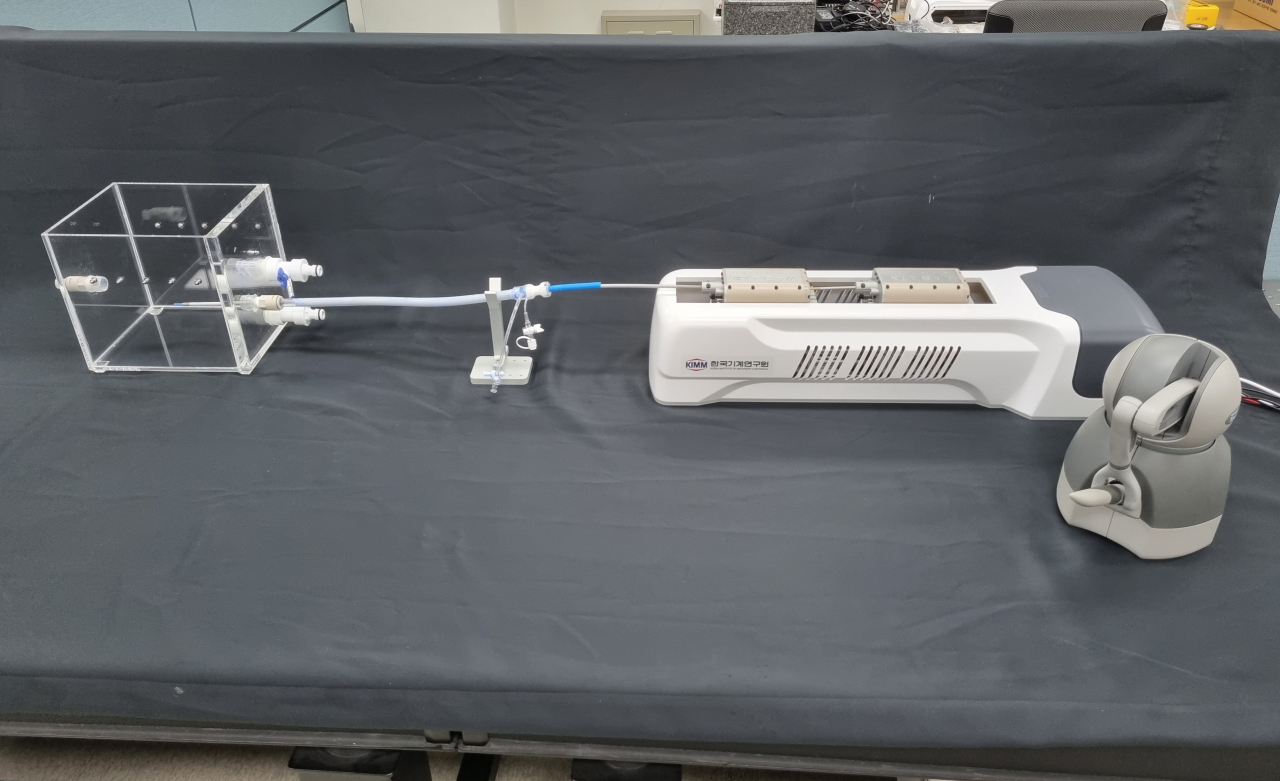Korean researchers develop robotic catheter
New breakthrough expected to help upgrade interventional therapies
By Kan Hyeong-wooPublished : April 18, 2022 - 15:27

South Korean researchers have developed the country’s first robotic catheter system that can be inserted into human organs to perform interventional therapies, the Korea Institute of Machinery and Materials said Monday.
A catheter is a thin tube-like medical device that can be inserted in the body to treat diseases or perform surgical procedures. Interventional therapies, which refer to treating surgery-requiring-diseases through non-surgical procedures, have been implemented in a wide range of medical fields, especially in cardiovascular treatment.
The new robotic catheter system, developed by a research team led by Kim Ki-young at the KIMM, is a curved guiding catheter that can be bent in two directions whereas the existing models could only be bent in one way. The purpose of a guiding catheter is to lead another catheter for treatment to its surgical location for deep insertion without damaging organ tissues.
The KIMM said the new system has two guiding catheters -- an outer catheter that stabilizes movement and an inner catheter that flexibly positions the device to its desired spot -- so it allows for an easier and simpler control.
According to the researchers, they developed a one-to-one linkage for each strand of the driving wire to operate the connected motor while using the technology that can control the variability of stiffness to adjust the tension of the robotic catheter.
The new robotic catheter prevents tissue damages as it uses a more flexible tube, unlike the conventional foreign products that use springs, the KIMM said. The new system also has the advantage of reducing radiation exposure of medical staff during the arrhythmia diagnosis process as the system is based on a robotics system, it added.
“This achievement is meaningful in that we developed a robotic catheter system, which can reduce radiation exposure with domestic technology, and made control of the catheter easier,” said Kim.
“We will help patients with heart, lung and bladder diseases through follow-up research for commercialization in cooperation with companies and hospitals.”
A catheter is a thin tube-like medical device that can be inserted in the body to treat diseases or perform surgical procedures. Interventional therapies, which refer to treating surgery-requiring-diseases through non-surgical procedures, have been implemented in a wide range of medical fields, especially in cardiovascular treatment.
The new robotic catheter system, developed by a research team led by Kim Ki-young at the KIMM, is a curved guiding catheter that can be bent in two directions whereas the existing models could only be bent in one way. The purpose of a guiding catheter is to lead another catheter for treatment to its surgical location for deep insertion without damaging organ tissues.
The KIMM said the new system has two guiding catheters -- an outer catheter that stabilizes movement and an inner catheter that flexibly positions the device to its desired spot -- so it allows for an easier and simpler control.
According to the researchers, they developed a one-to-one linkage for each strand of the driving wire to operate the connected motor while using the technology that can control the variability of stiffness to adjust the tension of the robotic catheter.
The new robotic catheter prevents tissue damages as it uses a more flexible tube, unlike the conventional foreign products that use springs, the KIMM said. The new system also has the advantage of reducing radiation exposure of medical staff during the arrhythmia diagnosis process as the system is based on a robotics system, it added.
“This achievement is meaningful in that we developed a robotic catheter system, which can reduce radiation exposure with domestic technology, and made control of the catheter easier,” said Kim.
“We will help patients with heart, lung and bladder diseases through follow-up research for commercialization in cooperation with companies and hospitals.”



![[AtoZ into Korean mind] Humor in Korea: Navigating the line between what's funny and not](http://res.heraldm.com/phpwas/restmb_idxmake.php?idx=644&simg=/content/image/2024/04/22/20240422050642_0.jpg&u=)
![[Exclusive] Korean military set to ban iPhones over 'security' concerns](http://res.heraldm.com/phpwas/restmb_idxmake.php?idx=644&simg=/content/image/2024/04/23/20240423050599_0.jpg&u=20240423183955)



![[Graphic News] 77% of young Koreans still financially dependent](http://res.heraldm.com/phpwas/restmb_idxmake.php?idx=644&simg=/content/image/2024/04/22/20240422050762_0.gif&u=)
![[Herald Interview] Why Toss invited hackers to penetrate its system](http://res.heraldm.com/phpwas/restmb_idxmake.php?idx=644&simg=/content/image/2024/04/22/20240422050569_0.jpg&u=20240422150649)






![[Exclusive] Korean military to ban iPhones over security issues](http://res.heraldm.com/phpwas/restmb_idxmake.php?idx=652&simg=/content/image/2024/04/23/20240423050599_0.jpg&u=20240423183955)



![[Today’s K-pop] Ateez confirms US tour details](http://res.heraldm.com/phpwas/restmb_idxmake.php?idx=642&simg=/content/image/2024/04/23/20240423050700_0.jpg&u=)